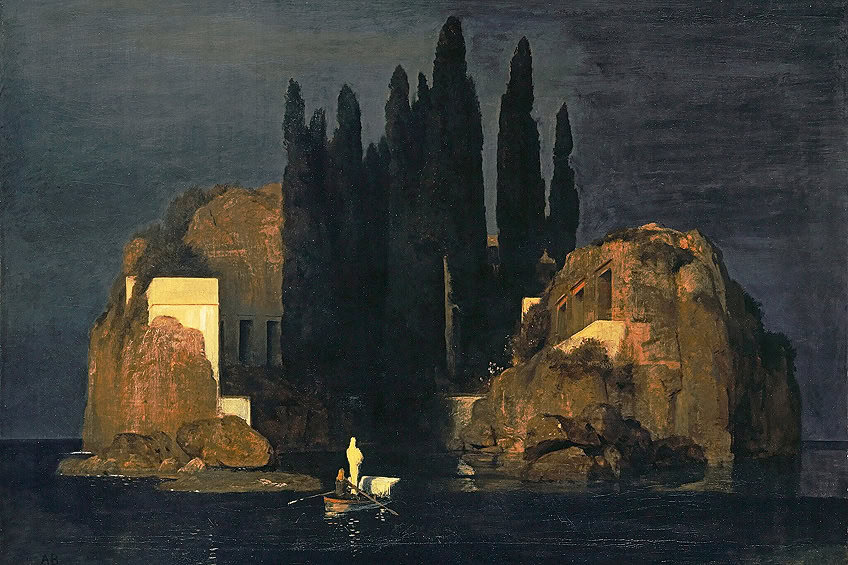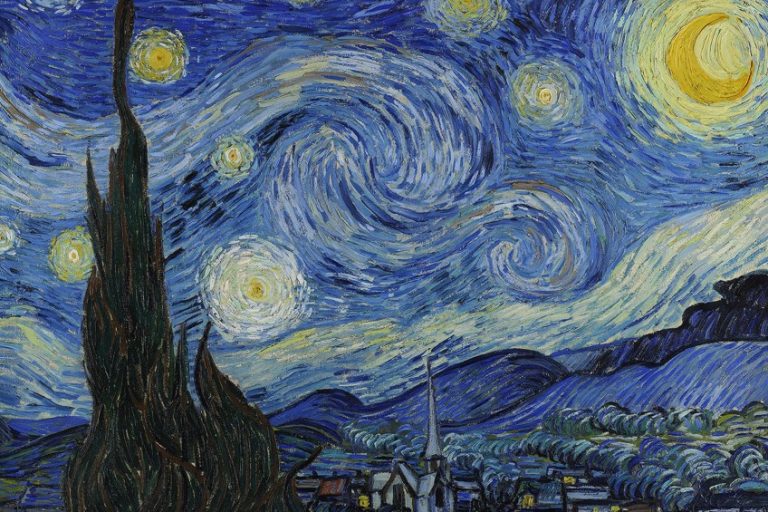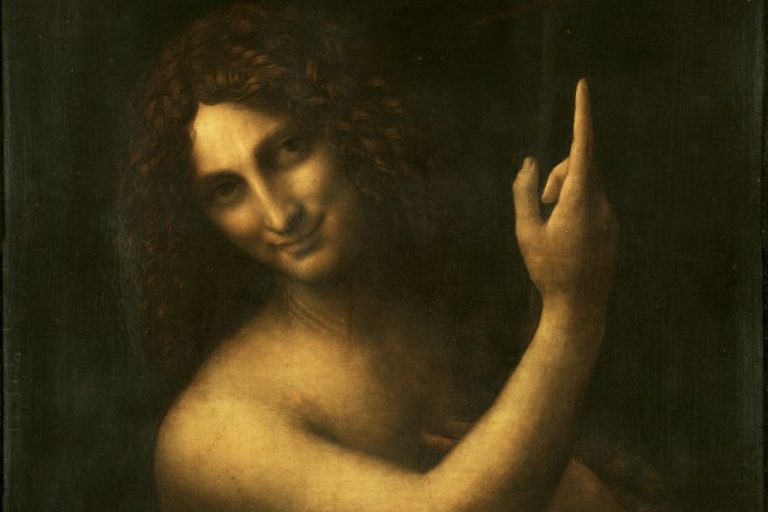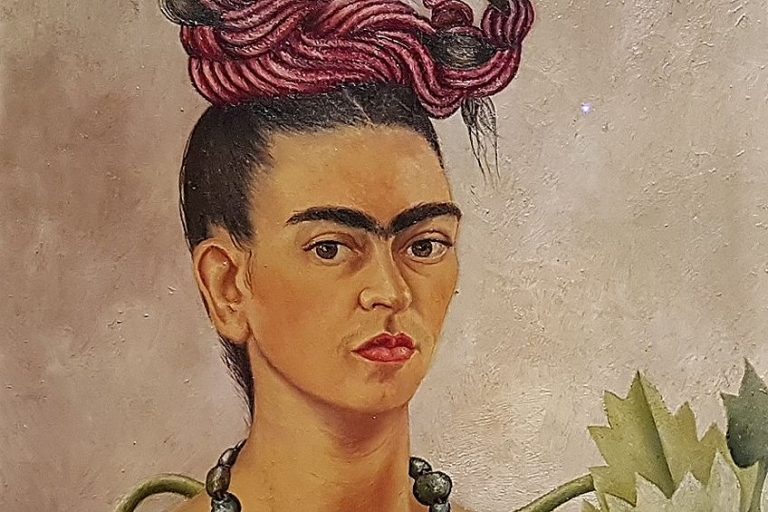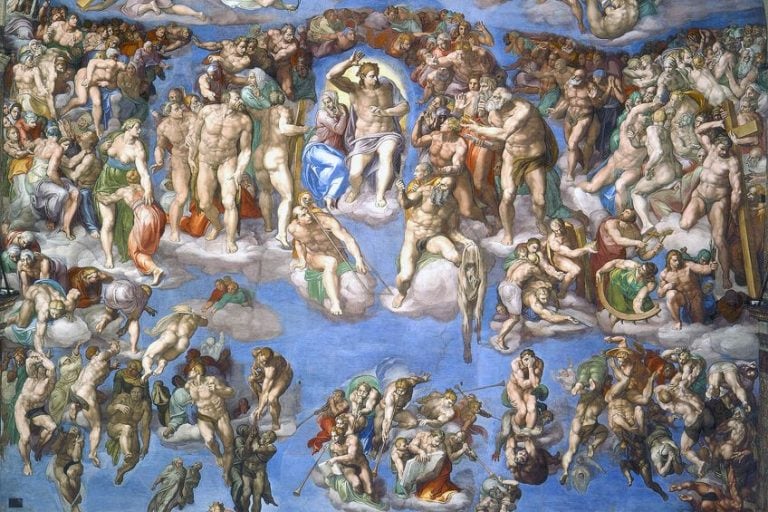“Isle of the Dead” by Arnold Böcklin – Art of the Macabre
Isle of the Dead, a haunting and enigmatic painting by Swiss symbolist artist Arnold Böcklin, captivates viewers with its melancholic and mystical atmosphere. Created in 1880, this work is one of five versions Böcklin painted, each depicting a small, rocky island dominated by cypress trees and surrounded by a dark, still sea. A solitary rowboat, carrying a shrouded figure and a coffin, approaches the island, evoking themes of death and the afterlife. The painting’s somber palette and eerie tranquility have inspired a wide range of interpretations, making it a profound example of 19th-century Symbolism and a testament to Böcklin’s fascination with the metaphysical and the sublime.
Key Takeaways
- Isle of the Dead explores themes of death and the afterlife.
- The painting was inspired by Böcklin’s time on Ischia.
- Five versions were created between 1880 and 1886.
Origins and Inspirations
| Artist | Arnold Böcklin (1827 – 1901) |
|---|---|
| Date Created | 1880 |
| Medium | Oil on canvas |
| Genre | Symbolism |
| Period/Movement | Symbolism |
| Dimensions (cm) | 80 x 150 |
| Series/Versions | Five versions, painted between 1880 and 1886 |
| Where Is It Housed? | Kunstmuseum Basel, Switzerland (original version) |
| What It Is Worth | Estimated value not publicly disclosed |
Arnold Böcklin’s Isle of the Dead stands as a striking example of Swiss Symbolist art, offering a haunting exploration of themes such as death and the afterlife. This enigmatic painting has captivated viewers since its creation, making it a central piece in Böcklin’s oeuvre. Produced in five different versions from 1880 to 1886, each iteration adds depth and intrigue to the artist’s vision. The painting was inspired by Böcklin’s memories of his stay on Ischia, where the Castello Aragonese left a profound impression on him. When Marie Berna commissioned a piece that evoked a dreamlike quality, Böcklin merged these memories with his fascination for death, creating a serene yet eerie representation.

The landscape’s ethereal quality invites viewers to contemplate their own perceptions of mortality and the unknown. Each version of Isle of the Dead has found its way into notable collections, with the first being created in 1880 and the fifth in 1886. The enigmatic scene has had a substantial cultural impact, inspiring artists and composers alike. During World War II, the fourth version suffered partial destruction due to Allied bombing, yet Böcklin’s vision endures, continuing to provoke thought and emotion.
Böcklin’s Muse and Symbolism
Arnold Böcklin found his muse in the landscapes and cemeteries of Florence, where he settled for much of his life. His time in the city influenced his artistic vision, especially the somber and tranquil settings that define his most famous work. The English Cemetery in Florence and its towering cypress trees served as crucial inspirations.
These elements are evident in the melancholic, yet serene ambiance of Isle of the Dead.
When the young widow Marie Berna visited Böcklin’s Florence studio in 1880, she requested a picture to dream by, stirring memories of landscapes viewed during his travels, such as San Michele in Venice. Böcklin’s symbolic use of allegory and mythological references reflects a meditative exploration of the afterlife and mourning.
European Cultural Context
The European cultural context of the 19th century played a pivotal role in shaping Böcklin’s Isle of the Dead. Influenced by the Symbolist movement, which sought to represent absolute truths through the symbolic imagery, Böcklin created work that mirrored the contemplative and introspective spirit of the time. The painting carries echoes of the ethereal landscapes painted by Caspar David Friedrich, a renowned figure in German Romanticism known for his solemn vistas and themes of nature’s sublime beauty.
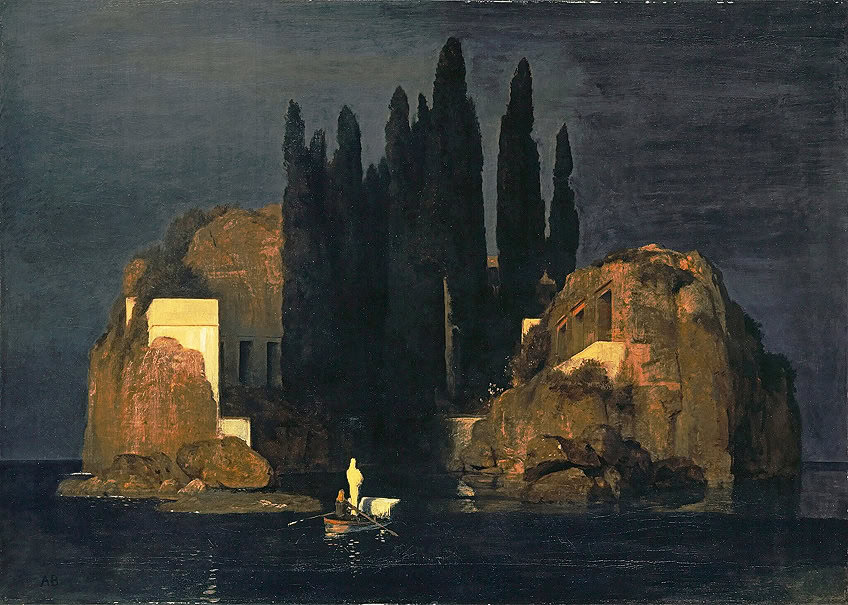
Böcklin, a Swiss artist, was also influenced by the late-Romantic musical compositions that often wove themes of mortality and nature. These cultural elements amalgamated in his work, creating a visual representation that resonated deeply with contemporary audiences and subsequent generations. The blend of personal experiences and broad cultural influences results in a masterwork that continues to captivate and inspire.
Artistic Analysis
Arnold Böcklin’s Isle of the Dead has intrigued viewers with its intricate symbolism and depiction of mortality. The painting captures themes of life and death through its detailed technique and enigmatic imagery.
Symbolism and Technique
Isle of the Dead is rich in symbolism. The dark, foreboding cemetery on the island suggests themes of mourning and loss. The island, surrounded by inky water, is a poignant representation of isolation in death. The cypress trees, often associated with cemeteries, symbolize mourning as well.
Böcklin’s technique is meticulous, using contrasting light and dark shades to evoke a sense of horror and mystery.
The moonlit water and the stark, white structure on the island contrast sharply, drawing the viewer’s eye and emphasizing the central motif of life and death. The careful brushwork and the ethereal quality of light further contribute to the painting’s somber mood.
Interpretations of Mortality
This artwork is considered one of Böcklin’s masterpieces, with multiple interpretations regarding the depiction of mortality. The solitary boatman ferrying a coffin to the island is an obvious nod to the journey from life to death. It positions the viewer to reflect on the transitional nature of existence.
The motif of an island as a final resting place conveys ideas of desolation and peace. Some see it as a symbol of the artist’s personal contemplation of life and afterlife. Böcklin spent his later years pondering these themes, which is evident in the recurrent imagery of Isle of the Dead across different versions.
The painting resonated strongly in central Europe, becoming a cultural touchstone that illustrated the quiet despair and solemn acceptance of mortality.
Notable Versions and Locations
Arnold Böcklin’s Isle of the Dead exists in five notable versions, each holding unique significance and historical context. These versions highlight the evolution of his ideas and the influence of different patrons and exhibitions.
Evolution Through Reiterations
Böcklin painted five versions of Isle of the Dead between 1880 and 1886.
- The first version from 1880 resides in Basel.
- The second version also from 1880 is known as the “New York” version.
- The third version created in 1883, was commissioned by the art dealer Fritz Gurlitt.
- The fourth version painted in 1884 was owned by industrial magnate Baron Heinrich Thyssen, partially destroyed during World War II.
- The fifth and final version in 1886 reflects a culmination of Böcklin’s evolving vision.
Each iteration shows slight variations in composition, lighting, and detail, indicative of his shifting artistic focus.
Public Collections and Exhibitions
The various versions are housed in prestigious institutions.
- The Basel version can be viewed in Basel.
- The New York version is located in New York City.
- The third version, commissioned by Fritz Gurlitt, resides in Berlin.
- Despite the damage, elements of the fourth version are preserved under the care associated with Baron Heinrich Thyssen.
- The fifth version is part of several prominent collections, celebrated for its detailed execution and depth.
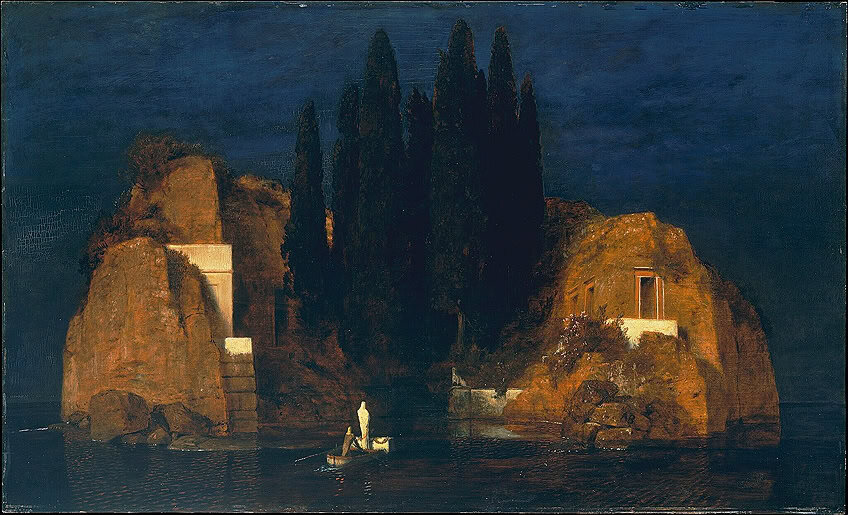
These paintings have inspired artists like Surrealist painter Salvador Dalí, who drew on Böcklin’s haunting imagery in their work. The pieces are frequently exhibited, confirming their ongoing importance in art history.
Cultural Impact and Legacy
The influence of Isle of the Dead by Arnold Böcklin extends into various artistic realms, inspiring notable works in music and literature and contributing to Böcklin’s enduring reputation.
Influence on Music and Literature
Isle of the Dead inspired several significant works in music and literature. Sergei Rachmaninoff’s symphonic poem, also titled Isle of the Dead, is a vivid example of Böcklin’s influence on music. Composed in 1908, Rachmaninoff uses orchestral textures to evoke the eerie and somber mood of Böcklin’s painting. Max Reger is another composer who found inspiration in Böcklin’s work, creating a set of Four Tone Poems that included an homage to Isle of the Dead.
The painting’s themes of mourning and existential reflection resonate through these musical interpretations.
In literature, Isle of the Dead appeared in Vladimir Nabokov’s novel, Despair. Nabokov references the painting as he weaves a complex narrative that mirrors the painting’s melancholic and contemplative tone. The painting’s moody and brooding atmosphere has made it a popular reference point for writers exploring themes of despair and introspection.
Böcklin’s Timeless Appeal
Arnold Böcklin’s Isle of the Dead maintains a captivating allure that transcends generations. The painting’s strong presence in various art forms highlights Böcklin’s ability to tap into universal themes. This work’s unique blend of symbolism and the stark depiction of an island surrounded by water resonates with viewers even today. The painting’s depiction of a solitary boat approaching a haunting island has become iconic, preserving Böcklin’s legacy in popular culture.
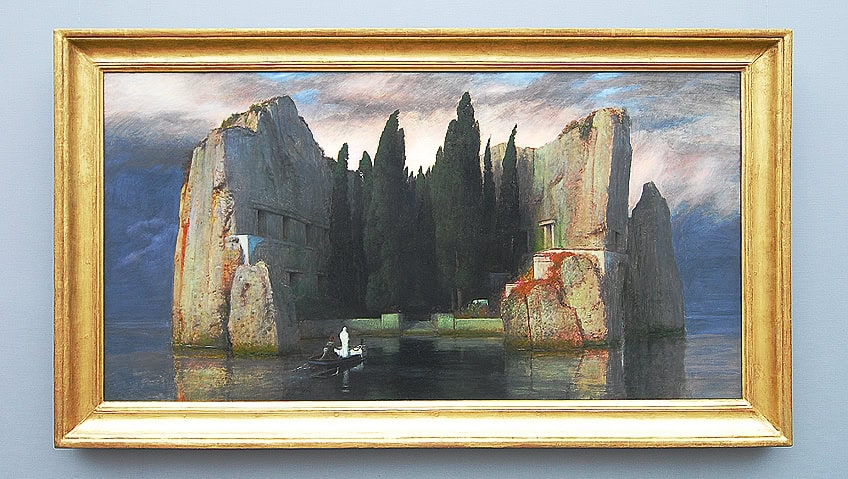
The painting’s rich symbolism attracts various interpretations, ensuring its relevance in modern and historical contexts. Böcklin’s vision continues to fascinate audiences with its timeless mystery and emotional depth, proving that Isle of the Dead is much more than just a painting—it’s a cultural artifact that inspires and challenges artists and thinkers across multiple mediums.
Isle of the Dead by Arnold Böcklin remains a masterful exploration of mortality and the unknown, leaving an indelible mark on both art and culture. Its profound symbolism and haunting imagery continue to resonate with audiences, inspiring countless adaptations in literature, music, and film. Böcklin’s ability to evoke such deep emotion and contemplation through his use of color, composition, and theme cements his place as a pivotal figure in Symbolist art. As viewers gaze upon the solitary island and the approaching boat, they are invited to reflect on their own perceptions of life and death, making Isle of the Dead a timeless and thought-provoking masterpiece.
Frequently Asked Questions
Where Is the Original Isle of the Dead Painting Located?
The Kunstmuseum Basel in Switzerland houses the original version of Isle of the Dead. This painting was completed in 1880 and remains one of Böcklin’s most celebrated works. The museum’s collection includes a wide array of European art, making it a fitting home for this evocative piece.
What Are the Interpretations of the Isle of the Dead Painting’s Symbolism?
Isle of the Dead has long been interpreted as a meditation on death and the afterlife. The painting’s moonlit island setting, shrouded in mystery, evokes a sense of solemnity and introspection. The small boat and solitary figure suggest a journey, often seen as a metaphor for the transition from life to death.
How Many Versions of Isle of the Dead Did Arnold Böcklin Create?
Arnold Böcklin created five versions of Isle of the Dead between 1880 and 1886. Each version retains the core elements of the rocky island and somber atmosphere but varies in detail and execution. The differing versions highlight Böcklin’s evolving vision and technique over time.
In What Ways Has Isle of the Dead Influenced Popular Culture and Media?
Isle of the Dead has profoundly influenced popular culture, particularly in film, literature, and music. The painting’s haunting imagery has inspired horror and fantasy genres, and it has been referenced or recreated in various media. Its enduring appeal continues to captivate audiences worldwide.
Isabella studied at the University of Cape Town in South Africa and graduated with a Bachelor of Arts majoring in English Literature & Language and Psychology. Throughout her undergraduate years, she took Art History as an additional subject and absolutely loved it. Building on from her art history knowledge that began in high school, art has always been a particular area of fascination for her. From learning about artworks previously unknown to her, or sharpening her existing understanding of specific works, the ability to continue learning within this interesting sphere excites her greatly.
Her focal points of interest in art history encompass profiling specific artists and art movements, as it is these areas where she is able to really dig deep into the rich narrative of the art world. Additionally, she particularly enjoys exploring the different artistic styles of the 20th century, as well as the important impact that female artists have had on the development of art history.
Learn more about Isabella Meyer and the Art in Context Team.
Cite this Article
Isabella, Meyer, ““Isle of the Dead” by Arnold Böcklin – Art of the Macabre.” Art in Context. July 2, 2024. URL: https://artincontext.org/isle-of-the-dead-by-arnold-bocklin/
Meyer, I. (2024, 2 July). “Isle of the Dead” by Arnold Böcklin – Art of the Macabre. Art in Context. https://artincontext.org/isle-of-the-dead-by-arnold-bocklin/
Meyer, Isabella. ““Isle of the Dead” by Arnold Böcklin – Art of the Macabre.” Art in Context, July 2, 2024. https://artincontext.org/isle-of-the-dead-by-arnold-bocklin/.


